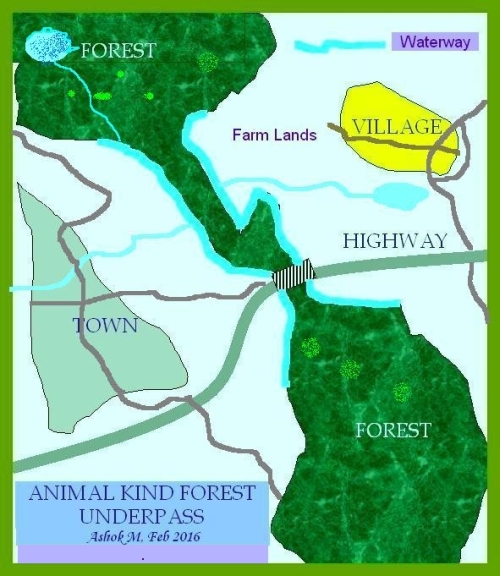Corridors of Compassion for forest animals
 |
| Animal Kind Forest Underpasses |
Over the past century, human population has increased
manifold. In order to meet needs of this population forests have been cleared.
This has put a great pressure on other animals for which forests are a home. Many
are on verge of extinction. Over the last two decades extreme climate events have
reminded humans that restoring forests is a way to stabilize climate. Needless
to say, this is good news for forest animals.
While new forests may be created, there is also a need to
connect existing ones with forest corridors to increase breathing room for
animals. An impediment in connecting forests or forest patches is the need for
highways and railway lines that pass through them. A way to prevent this
interruption is to construct a concrete underpass of a minimum length of 200
feet, a kind of tunnel through which the highway or rail line passes and over
which a forest grows.
A narrow corridor of forest can be protected by water
channels on either side that are rain fed and are more natural and useful for
animals than fencing or wall might be.
They also encourage animals to approach the corridor and use it. Care must be
taken to slope the waterway very gradually on the forest side at least in
patches so that animals may be able to reach water when level is low. If water
dries up in these channels in dry months or years, they shall still protect
animals from wandering out because on the other side a steep drop may be made
that acts like a wall.
The soil from digging the waterway is what may be used to
cover the highway underpass for vegetation growth. The topsoil must first be
scraped and set aside and then used for covering the newly placed soil so that
it is nutritive for plants. Some fertilization may be done on new soil soon
after construction in order to give it a quick start. While only grass and
bushes may grow on top of the underpass because of thin layer of soil there,
trees can be grown on the sides. They would help stabilize the soil too while
making the animals feel safe in crossing over. The water ways on either side of the highway just before and after the underpass may be connected through an underground connection (a large pipe or sewerage type), a passage not just for water but also life within, including fish if any.
 |
| https://twitter.com/CamilleStein/status/677497631795519488 |
The two figures with this note are illustrative schematics of the concept.
Precise dimensions are not given here but can be worked out easily for each
forest location by engineers and forest experts. If needed this author may be
contacted through a comment to this note for more details. These corridors do not cost much because apart from the 200 feet long concrete structure, rest is soil work requiring no materials. The concrete part may be made with concrete blocks for sides and a concrete roof.Protective fencing would be required for the portion just on top of the underpass to prevent any animal on the edge from inadvertently falling off.
Note: Images of forest and tiger are from www.publicdomainpictures.net/
Note: Images of forest and tiger are from www.publicdomainpictures.net/
UPDATE October 12, 2016: Read more on this subject in this excellent article the blogger just found through a tweet about it: http://www.mnn.com/leaderboard/blogs/why-wild-animals-need-wildlife-corridors?utm_content=buffer490a0&utm_medium=social&utm_source=twitter.com&utm_campaign=planetgreen



Comments